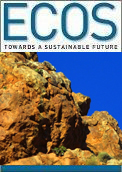
|
Published: 20 February 2012
Managing buffel grass benefits native animals and fire regimes
An arid zone ecologist has found a distinct difference in the abundance and number of species of frogs, lizards, snakes and small animals in areas where buffel grass (Cenchrus ciliaris) has been removed compared with areas that are left unmanaged.
‘This is the first clear evidence that controlling the grass has positive effects for native fauna,’ says Dr Schlesinger of Charles Darwin University (CDU).
Dr Schlesinger worked on this collaborative project with Professor Keith Christian, professor of zoology at CDU, and members of the Alice Springs Desert Park and Parks and Wildlife Service in the southern Northern Territory.
Buffel grass is a major environmental weed in arid Australia. It was introduced by Afghan cameleers and, more recently, has been widely planted by pastoralists and government departments to increase productivity and reduce erosion by stabilising ground cover. It is still valued by the pastoral industry.
There has been increasing concern, particularly in protected areas, about the effects of the grass on fire frequency and on plant and animal communities.
Dr Schlesinger has been gathering data from experimental sites at Simpsons Gap and the Desert Park in the West MacDonnell ranges since 2008.
Half the plots are heavily overgrown with buffel grass while the other half, which are managed by the Simpsons Gap Rangers and the Alice Springs Desert Park, are dominated by native grasses and forbs. High densities of buffel grass at Simpson’s Gap have affected fire regimes in recent years and vegetation communities have changing, with fire-tolerant shrubs now dominating the canopy and long-lived corkwood trees dying.
Rangers control the buffel grass by slashing and follow-up poisoning. Control can be challenging because there is only a brief period after rain when poisoning is effective, and in the arid zone it is impossible to know when the next rain event will happen.
Slashing immediately reduces the ground cover, which lowers the risk of fire as well as changing the structural habitat for other plants and animals. But without follow-up poison, the grass returns with renewed vigour.
In addition to these control methods, Dr Schlesinger says, two unplanned wildfires last year presented a rare opportunity to compare the behaviour of fire in areas with and without buffel grass.
‘While the fire virtually decimated the areas with dense buffel grass, the native grasses remained almost completely unburnt after the first cool season fire in June, and the native grass areas that did burn under hotter conditions in August still contained unburnt patches.
‘Again we see clear benefits to control, with the risk and intensity and of fire significantly reduced in managed areas,’ says Dr Schlesinger.
Source: Charles Darwin University




